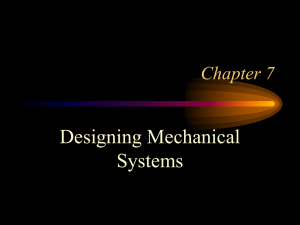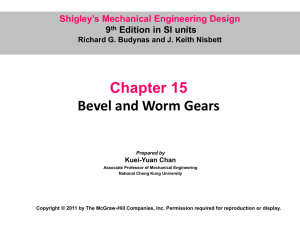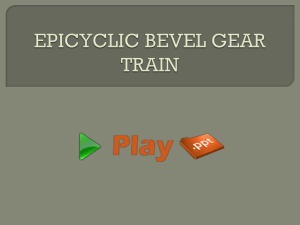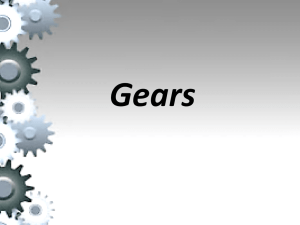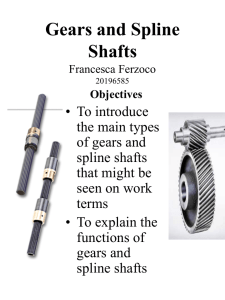ME3180 Gear Note #1 - The George W. Woodruff School of
advertisement
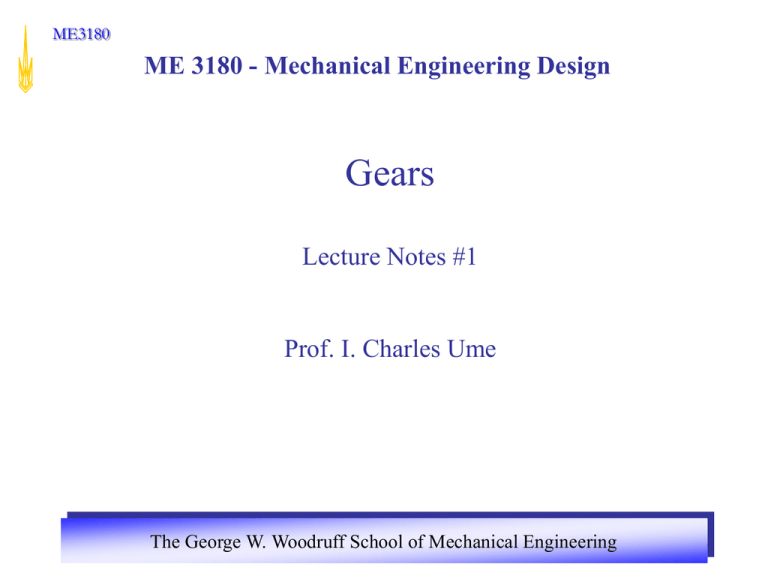
ME3180 ME 3180 - Mechanical Engineering Design Gears Lecture Notes #1 Prof. I. Charles Ume The George W. Woodruff School of Mechanical Engineering ME3180 Why Do We Use Gears ? Reduce or increase speed Reduce or increase torque Transmit power around corners or over distances We want (at various times) • Efficiency • Reliability • Accuracy • Smoothness • Quiet operation The George W. Woodruff School of Mechanical Engineering ME3180 Types of Gears Types of Gears: • Spur and Helical – Used for parallel shafts • Helical • Bevel • Worm These three can be used for nonparallel shafts. Spur Gears American Gear Manufacturing Association (AGMA) • Defined the standard used in the text • There are other standards... Study Tables 13-1 thru 13-5 Shigley • Table has all necessary terms for gears Worm Gears Helical Gears Bevel Gears Images From: Boston Gear and Chicago Gear Works The George W. Woodruff School of Mechanical Engineering ME3180 Spur Gears Metal Spur Gears Used to transmit torque and angular velocity More efficient than simple rolling cylinders because there is no slip Designed to work on parallel shafts Teeth are parallel to shaft Common Uses: • Watches, Clocks, Printers • Rack - Car Steering, Diving Boards Rack and Pinion Images From: Chicago Gear Works and Small Parts Inc Delrin Spur Gears The George W. Woodruff School of Mechanical Engineering ME3180 Helical Gears Teeth are angled with respect to the axis of rotation (10-45o) Direction of angle determines "hand" of gear Two configurations: Parallel - two gears with opposite hands on parallel axes Helical Gears Crossed-Same hand gears perpendicular to each other Used to reduce noise and vibration (parallel) Used in distributors and speedometers (crossed) Images From: Norton and Chicago Gear Works The George W. Woodruff School of Mechanical Engineering ME3180 Bevel Gears Cut on mating cones instead of mating cylinders (like spur, helical) Axes intersect at the apices of mating cones Two types of bevel gears • Straight - teeth run straight up to apex of cone • Spiral - teeth cut at curved angles up around the cone Bevel Gears Spiral bevel gears run more smoothly and quietly than straight bevel gears Images From: Norton and Boston Gear The George W. Woodruff School of Mechanical Engineering ME3180 Worm Gears A worm gear and a worm together are called a wormset • Worm – Helical gear with one continuous tooth – Analogous to screw thread • Worm Gear – Analogous to a nut Connects non-parallel and nonintersecting shafts (usually at right angles) Advantages • High gear ratios in small packages because worm only has one tooth (typically up to 100:1) • Usually self locking Worm Gears Images From: Norton and Chicago Gear Works The George W. Woodruff School of Mechanical Engineering ME3180 ME 3180 - Mechanical Engineering Design Spur Gears Lecture Notes The George W. Woodruff School of Mechanical Engineering ME3180 Gear Tooth Theory Simplest means of transferring rotary motion from one shaft to another is by two or more rolling cylinders When teeth are added to the rolling cylinders, they become gears and are called a gearset • Pinion - Smallest gear in a gearset • Gear - Larger gears in a gearset • Rack - Linear gear if gear is a straight bar The George W. Woodruff School of Mechanical Engineering ME3180 Fundamental Law of Gearing The angular velocity ratio, mV, between gears of a gearset must remain constant thoughout the mesh out rin N in mV in rout N out out = angular velocity of output gear in = angular velocity of input gear rin = pitch radius of input gear (Eq. 11.1a) rout= pitch radius of output gear Nin = number of teeth on input gear Nout = number of teeth on output gear The + sign depends on internal or external gearset – External gearset reverses direction of rotation between input and output gears. External gearset requires a negative sign (-) – Internal gearset has same direction of rotation of input and output gears. Internal gearset requires a positive sign (+) The George W. Woodruff School of Mechanical Engineering ME3180 Fundamental Law of Gearing Mechanical advantage (torque ratio), mA, is the reciprocal of mV This means that torque is exchanged for velocity in rout N out 1 mA mV out rin N in (Eq. 11.1b) Gear Ratio, mG, is what is commonly referred to when specifying gear trains • It is the magnitude of either the velocity ratio or torque ratio, whichever is > 1. mG mV or mG mA for mG 1 (Eq. 11.1c) The George W. Woodruff School of Mechanical Engineering ME3180 Gear Tooth Shape Gear tooth contours must be conjugates of each other. When tooth profiles, or cams, are designed to produce constant angular velocity ratio during meshing, they are said to have conjugate action. The following tooth profiles will produce conjugates: • Cycloid – Used in watches and clocks • Involute – Most common type used in gears – Principle Advantage: ensures that center-distance errors do not affect velocity ratio Generating an Involute • String is tangent to base circle • Center of curvature is point of tangency of string with base circle • Tangent to involute is normal to string The George W. Woodruff School of Mechanical Engineering ME3180 Examples of Conjugate Gears and Cams The George W. Woodruff School of Mechanical Engineering ME3180 Construction of Involute Profile The George W. Woodruff School of Mechanical Engineering



